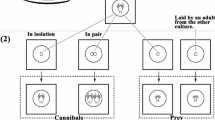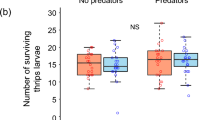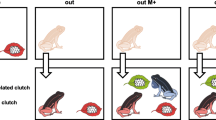Abstract
Animals often select oviposition sites to minimize the predation risk for eggs and juveniles, which are more vulnerable to predation than adults. When females produce eggs in clusters, the eggs and juveniles are likely to suffer from cannibalism. Although cannibalism among siblings is known to be lower than among non-siblings, there have been few investigations into the possibility that females select oviposition sites that reduce the risk of cannibalism for the offspring. To test this possibility, we examined oviposition preference by adult females of the predatory mite Gynaeseius liturivorus in response to the presence of her own eggs and to eggs of other females, offering plastic discs as oviposition substrates. Although females did not clearly show a preference for plastic discs on which they had oviposited, they avoided plastic discs on which other females had oviposited. When eggs of other females were artificially placed on clean plastic discs, adult female mites avoided these discs, suggesting that the eggs were used as cues for oviposition preference. Cannibalism among juvenile siblings was lower than among non-siblings. These observations show that adult females and juveniles of G. liturivorus discriminate kin relationships among conspecific individuals. Therefore, oviposition preference by adult female G. liturivorus may lead to the reduced risk of cannibalism among offspring.



Similar content being viewed by others
References
Agrawal AA, Kobayashi C, Thaler JS (1999) Influence of prey availability and induced host-plant resistance on omnivory by western flower thrips. Ecology 80:518–523
Alberts SC (1999) Paternal kin discrimination in wild baboons. Proc R Soc Lond B Biol Sci 266:1501–1506
Almohamad R, Verheggen F, Francis F et al (2010) Assessment of oviposition site quality by aphidophagous hoverflies: reaction to conspecific larvae. Anim Behav 79:589–594
Andersson M, Waldeck P, Hanssen SA, Moe B (2015) Female sociality and kin discrimination in brood parasitism: unrelated females fight over egg laying. Behav Ecol 26:755–762
Atakan E, Coll M, Rosen D (1996) Within-plant distribution of thrips and their predators: effects of cotton variety and developmental stage. Bull Entomol Res 86:641–646
Aubret F, Bonnet X, Shine R, Maumelat S (2005) Why do female ball pythons (Python regius) coil so tightly around their eggs? Evol Ecol Res 7:743–758
Baur B (1988) Population regulation in the land snail Arianta arbustorum: density effects on adult size, clutch size and incidence of egg cannibalism. Oecologia 77:390–394
Bayoumy MH, Abou-Elnaga AM, Ghanim AA, Mashhoot GA (2016) Egg cannibalism potential benefits for adult reproductive performance and offspring fitness of Coccinella undecimpunctata L. (Coleoptera: Coccinellidae). Egypt J Biol Pest Control 26:35
Bonadonna F, Sanz-Aguilar A (2012) Kin recognition and inbreeding avoidance in wild birds: the first evidence for individual kin-related odour recognition. Anim Behav 84:509–513
Boos S, Meunier J, Pichon S, Kölliker M (2014) Maternal care provides antifungal protection to eggs in the European earwig. Behav Ecol 25:754–761
Bortolotti GR, Wiebe KL, Iko WM (1991) Cannibalism of nestling American kestrels by their parents and siblings. Can J Zool 69:1447–1453
Buzatto BA, Requena GS, Martins EG, Machado G (2007) Effects of maternal care on the lifetime reproductive success of females in a neotropical harvestman. J Anim Ecol 76:937–945
Byers CJ, Eason PK (2009) Conspecifics and their posture influence site choice and oviposition in the damselfly Argia moesta. Ethology 115:721–730
Choh Y, Sabelis MW, Janssen A (2017) Predatory interactions between prey affect patch selection by predators. Behav Ecol Sociobiol 71:66
Christiansen IC, Schausberger P (2017) Interference in early dual-task learning by predatory mites. Anim Behav 133:21–28
de Bruijn PJ, Sabelis MW, Egas M (2014) Effects of kinship or familiarity? small thrips larvae experience lower predation risk only in groups of mixed-size siblings. Behav Ecol Sociobiol 68:1029–1035
de Nardin J, Missaggia BO, Araújo AM (2015) An experimental approach to test the source of information on kinship in butterfly immatures. Ethol Ecol Evol 27:294–305
D’Ettorre P, Heinze J, Ratnieks FL (2004) Worker policing by egg eating in the ponerine ant Pachycondyla inversa. Proc R Soc Lond B Biol Sci 271:1427–1434
Dobler R, Kölliker M (2009) Kin-selected siblicide and cannibalism in the European earwig. Behav Ecol 21:257–263
Dudley SA, File AL (2007) Kin recognition in an annual plant. Biol Lett 3:435–438
Elgar MA, Crespi BJ (1992) Cannibalism: ecology and evolution among diverse taxa. Oxford University Press, Oxford
El-Showk S, van Zweden JS, d’Ettorre P, Sundström L (2010) Are you my mother? Kin recognition in the ant Formica fusca. J Evol Biol 23:397–406
Faraji F, Janssen A, Van Rijn PCJ, Sabelis MW (2000) Kin recognition by the predatory mite Iphiseius degenerans: discrimination among own, conspecific, and heterospecific eggs. Ecol Entomol 25:147–155
Faraji F, Janssen A, Sabelis MW (2002) Oviposition patterns in a predatory mite reduce the risk of egg predation caused by prey. Ecol Entomol 27:660–664
Fox LR (1975) Cannibalism in natural populations. Annu Rev Ecol Syst 6:87–106
Gerlach G, Lysiak N (2006) Kin recognition and inbreeding avoidance in zebrafish, Danio rerio, is based on phenotype matching. Anim Behav 71:1371–1377
Giffney RA, Kemp DJ (2016) Maternal care behaviour and kin discrimination in the subsocial bug Tectocoris diophthalmus (Hemiptera: S cutelleridae). Austral Entomol 55:170–176
Gilad O, Swaisgood RR, Owen MA, Zhou X (2016) Giant pandas use odor cues to discriminate kin from nonkin. Curr Zool 62:333–336
Green WW, Mirza RS, Pyle GG (2008) Kin recognition and cannibalistic behaviours by adult male fathead minnows (Pimephales promelas). Naturwissenschaften 95:269–272
Griesser M, Suzuki TN (2016) Kinship modulates the attention of naïve individuals to the mobbing behaviour of role models. Anim Behav 112:83–91
Grostal P, Dicke M (1999) Direct and indirect cues of predation risk influence behavior and reproduction of prey: a case for acarine interactions. Behav Ecol 10:422–427
Hager R, Johnstone RA (2007) Maternal and offspring effects influence provisioning to mixed litters of own and alien young in mice. Anim Behav 74:1039–1045
Helanterä H, d’Ettorre P (2015) A comparative study of egg recognition signature mixtures in Formica ants. Evolution 69:520–529
Hesse S, Anaya-Rojas JM, Frommen JG, Thünken T (2015) Kinship reinforces cooperative predator inspection in a cichlid fish. J Evol Biol 28:2088–2096
Janssen A, Willemse E, Van Der Hammen T (2003) Poor host plant quality causes omnivore to consume predator eggs. J Anim Ecol 72:478–483
Kasina M, Nderitu J, Nyamasyo G et al (2009) Within-plant distribution and seasonal population dynamics of flower thrips (Thysanoptera: Thripidae) infesting French beans (Phaseolus vulgaris L.) in Kenya. Span J Agric Res 7:652–659
Kudô S, Satô M, Ôhara M (1989) Prolonged maternal care in Elasmucha dorsalis (Heteroptera: Acanthosomatidae). J Ethol 7:75–81
Loeb ML, Diener LM, Pfennig DW (2000) Egg-dumping lace bugs preferentially oviposit with kin. Anim Behav 59:379–383
Magalhães S, Janssen A, Montserrat M, Sabelis MW (2005) Prey attack and predators defend: counterattacking prey trigger parental care in predators. Proc R Soc Lond B Biol Sci 272:1929–1933
Martini X, Dixon AFG, Hemptinne J-L (2013) The effect of relatedness on the response of Adalia bipunctata L. to oviposition deterring cues. Bull Entomol Res 103:14–19
Mateo JM (2004) Recognition systems and biological organization: the perception component of social recognition. Annales Zoologici Fennici 41:729–745
Matsuura K, Tanaka C, Nishida T (2000) Symbiosis of a termite and a sclerotium-forming fungus: sclerotia mimic termite eggs. Ecol Res 15:405–414
Montserrat M, Janssen A, Magalhães S, Sabelis MW (2006) To be an intra-guild predator or a cannibal: is prey quality decisive? Ecol Entomol 31:430–436
Munga S, Minakawa N, Zhou G et al (2006) Effects of larval competitors and predators on oviposition site selection of Anopheles gambiae sensu stricto. J Med Entomol 43:221–224
Munguía-Steyer R, Favila ME, Macías-Ordóñez R (2008) Brood pumping modulation and the benefits of paternal care in Abedus breviceps (Hemiptera: Belostomatidae). Ethology 114:693–700
Parsons W, Zhong W, Rudolf VH (2013) Mating status and kin recognition influence the strength of cannibalism. Anim Behav 85:365–369
Peddle S, De Groot P, Smith S (2002) Oviposition behaviour and response of Monochamus scutellatus (Coleoptera: Cerambycidae) to conspecific eggs and larvae. Agric For Entomol 4:217–222
Pervez A, Gupta AK (2004) Role of surface chemicals in egg cannibalism and intraguild predation by neonates of two aphidophagous ladybirds, Propylea dissecta and Coccinella transversalis. J Appl Entomol 128:691–695
Pfennig DW, Sherman PW, Collins JP (1994) Kin recognition and cannibalism in polyphenic salamanders. Behav Ecol 5:225–232
Polis GA (1981) The evolution and dynamics of intraspecific predation. Annu Rev Ecol Syst 12:225–251
Poo S, Bickford DP (2013) The adaptive significance of egg attendance in a south-east Asian tree frog. Ethology 119:671–679
Pusey A, Wolf M (1996) Inbreeding avoidance in animals. Trends Ecol Evol 11:201–206
Raitanen J, Forsman JT, Kivelä SM et al (2014) Attraction to conspecific eggs may guide oviposition site selection in a solitary insect. Behav Ecol 25:110–116
R Development Core Team (2016) R: A language and environment for statistical computing [Computer software]. R Foundation for Statistical Computing, Vienna
Saitoh F, Choh Y (2018) Do intraguild prey protect their eggs from intraguild predators that share their oviposition site? Anim Behav 140:49–55
Schausberger P (2004) Ontogenetic isolation favours sibling cannibalism in mites. Anim Behav 67:1031–1035
Schausberger P (2005) The predatory mite Phytoseiulus persimilis manipulates imprinting among offspring through egg placement. Behav Ecol Sociobiol 58:53–59
Schausberger P (2007) Kin recognition by juvenile predatory mites: prior association or phenotype matching? Behav Ecol Sociobiol 62:119–125
Schausberger P, Croft BA (2001) Kin recognition and larval cannibalism by adult females in specialist predaceous mites. Anim Behav 61:459–464
Schausberger P, Hoffmann D (2008) Maternal manipulation of hatching asynchrony limits sibling cannibalism in the predatory mite Phytoseiulus persimilis. J Anim Ecol 77:1109–1114
Schultner E, d’Ettorre P, Helanterä H (2013) Social conflict in ant larvae: egg cannibalism occurs mainly in males and larvae prefer alien eggs. Behav Ecol 24:1306–1311
Sherman P, Reeve H, Pfennig D (1997) Recognition systems. In: Krebs J, Davies N (eds) Behavioural ecology, 4th edn. Blackwell Science, Oxford, pp 69–96
Steiner MY, Goodwin S (2005) Management of thrips (Thysanoptera: Thripidae) in Australian strawberry crops: within-plant distribution characteristics and action thresholds. Austral Entomol 44:175–185
Whitehorn PR, Tinsley MC, Goulson D (2009) Kin recognition and inbreeding reluctance in bumblebees. Apidologie 40:627–633
Acknowledgements
This work was supported by the Sasakawa Scientific Research Grant from The Japan Science Society (Grant No. 29-512 to F.S.) and the Japan Society for Promotion of Science (Basic Research C; Grant No. 23570018 to Y.C.).
Author information
Authors and Affiliations
Corresponding author
Rights and permissions
About this article
Cite this article
Saitoh, F., Choh, Y. Role of kin recognition in oviposition preference and cannibalism by the predatory mite Gynaeseius liturivorus. Exp Appl Acarol 76, 149–160 (2018). https://doi.org/10.1007/s10493-018-0298-z
Received:
Accepted:
Published:
Issue Date:
DOI: https://doi.org/10.1007/s10493-018-0298-z




